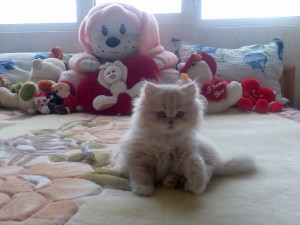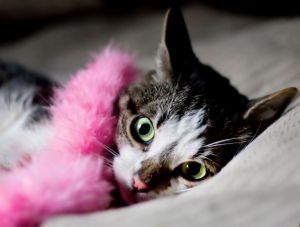Q: “I just read your scratching article and yes, my declawed kitty wants to chase the ball, but can’t grasp it, and gets frustrated (even “embarrassed”). I think the laser light, which is uncatchable, also must be frustrating. He gets tired of the pole toys. What should I do???” – Beth
A: Declawed kitties are definitely at a disadvantage compared to cats with claws. Declawing is the amputation of the distal phalanges or toe bones. Cats with claws can hold onto and grasp objects. To compensate for their lack of claws, declawed kitties have to awkwardly wrap their arms and paws around toys and objects. When a declawed kitty tries to hold onto and grasp an object or toy, the toy usually slips right out of their paws. This can make play frustrating and difficult for them.
Here are some tips to make play more rewarding for declawed kitties.
1) Make pole toys enticing by using the pole as a toy. Move the wand or pole under pillows, bedding, blankets or rugs. Turn it into a game of hide and seek. Make sure the pole toy ‘freezes’ or remains motionless when it is underneath something. Your kitty will pounce on the rug or dodge directly into the blankets after the pole. Move the pole away from your kitty, keeping the pole flush to the ground or on a surface. After moving the pole, stop moving it. Keep it motionless, so your kitty will pounce on it again. (No claws needed and kitties with claws love the game too).
2) Get long pole toys with long plain cord or string attached (If needed, you can make your own). Move the cord or string as if it were a prey animal so that your kitty can ‘stalk’ the string. If the string quivers on the floor and slinks around a corner, your kitty will stalk and chase it. Stop moving the string so that it remains motionless and plays dead. When your kitty ‘catches’ it, keep the string still for a minute or two. This way your kitty can ‘catch’ the string. When your kitty lets go or steps away to watch again, repeat by slowly moving the string.
3) Encourage the biting of toys. When your kitty bites the toy, stop moving it. He’ll then let go, paw at it and want you to move it again.
4) Get larger catnip type kicking toys or stuffed cat toys that aren’t too small. Move them under bags, pillows and rugs. When he ‘catches’ the larger toy, you can tickle his tummy with it, and he may hold onto it and bunny kick. Since the toys will be larger, he can hold onto them. (Larger toys are better for cats to hold onto and bunny kick with their back legs. Smaller toys are better to elicit a cat’s stalking and chasing behaviors).
5) Use crinkled paper on the ends of pole toys (you can make them yourself). Crinkled paper is slightly easier for a cat to hold onto. Again, make the wand toy act like prey. Most people play with their cats by swinging the toy over the cat’s head or repeatedly in the cat’s direction. Prey doesn’t act this way. This is why many cats, especially older cats, dislike playing. Make toys act like real prey. Prey animals hide, freeze, slink or scurry away, and retreat. That’s what makes it exciting for the cat.
6) Use a flat piece of loose-leaf paper and simply move it along the floor. Cats usually love this. They will slide along with the paper or chase and pounce on it. Claws aren’t needed for this game.
7) Always feed your cat treats or snacks once your cat catches a toy in his paws or his mouth and after play winds down, as well as to signal that play is over. Cats hunt (play), eat, and then sleep. By keeping the toy motionless when your kitty catches it and it is in his possession and then treating him, it will be equivalent to him catching or killing the prey (toy), and he will feel a sense of accomplishment.
Please note: Declawing is a painful and invasive procedure. It is an amputation. Botched up surgeries are not uncommon. Pain and complications can last for months, if not years, and sometimes for the entire lifetime of the cat. Declawing can create behavioral problems, such as general timidity, avoidance of owners, hiding and retreating, biting (especially associated with play aggression), and failure to use the litter box.
Copyright © Alana Stevenson 2013
Also see How to Play with Your Cat
Kitty Destroying Sofa and Declawing
Alana Stevenson provides consultations by phone and Skype. She can be contacted through her website www.AlanaStevenson.com


I just adopted a senior Persian cat that was declawed. It really takes the joy out of playing. Jackson Galaxy has so many ways you can stop a cat from scratching your furniture. I have bought so many toys and condos for this cat but he just cannot enjoy his life! If I had to do it again I would take a cat with claws and just put the tips on the cats which seem to be very effective. Once a month to redo doesn’t seem like a big deal. No criticisms to those that choose declawing but it really does interfere with a cats quality of life! I adopted this homeless guy and therefore I got what was already in place.
I have adopted 2 now older declawed cats. As a senior I will not allow cat outside. They need love also. My first one didn’t seem to care she was declawed. The kitty I have now is 10. She seems to have sore hips (taking to vet). She won’t jump. Only had her a month. She was allowed outside! I won’t let her out. She is not happy but coming around. Please don’t stay away because cat is declawed. They aren’t broke or deformed.
I adopted an adult gal a few years back and was pretty sore to find out that she was declawed. I’ve been doing everything I can to make playtime as fun as possible. She loves laser lights and catnip filled toys! I like to play hide-and-seek with her – i run to one side of the house and peek my head out to her, once i pop back and hide, she charges for me and we both put our hands/paws in the air as if we were surprised. It’s so cute and so fun.